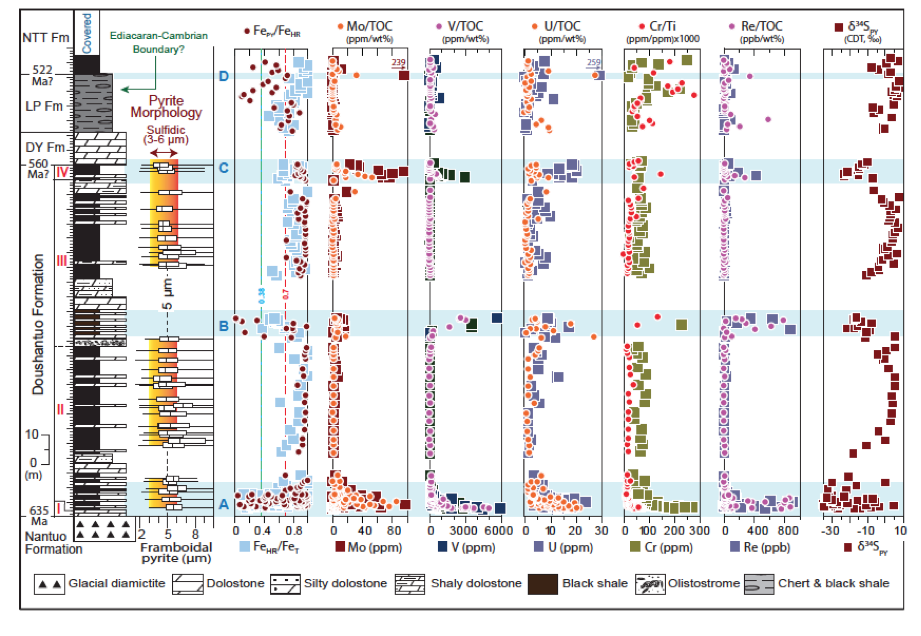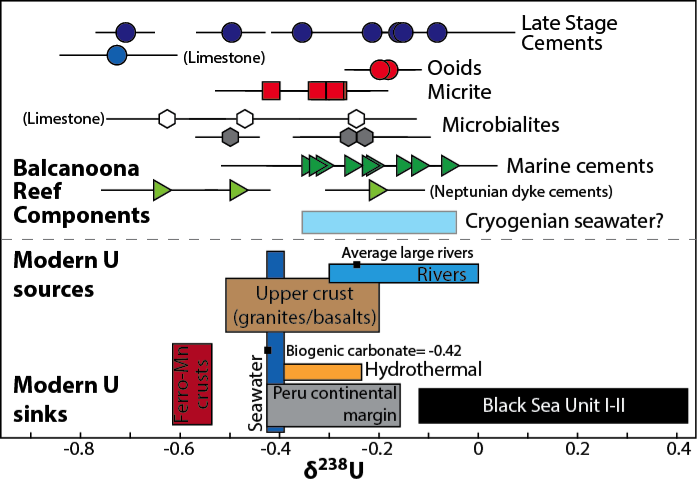The Rise of Complexity Amid Environmental Turmoil
Project Summary
Climatic turmoil and major upheavals in global biogeochemical cycles characterize the latter part of the Proterozoic Eon, during the so-called Neoproterozoic (1,000–541 million years ago). The Neoproterozoic was marked by pronounced shifts in atmospheric composition—especially increased oxygen levels. This environmental instability provided the backdrop for the rise of complex life, including animals; however, limited empirical constraints have hindered attempts to untangle the cause-and-effect relationships among biological innovations, shifts in ecosystem complexity, and biogeochemical evolution. Likewise, sparse records make it difficult to gauge whether the Neoproterozoic unfolded as a unidirectional march toward greater organismal complexity and higher oxygen levels, as traditionally envisioned, or whether dramatic swings in surface oxygen levels accompanied non-unidirectional shifts in ecological complexity. To resolve this debate, we are producing extensive high-resolution records of oxygen levels and tracking the distribution, abundance, and impact of eukaryotic phytoplankton over this critical interval. Our central goal is to work synergistically with the Origins of Complexity NAI Team to better understand how the rise of complex life shaped planetary-scale biosignatures.
Updates
-
Refining the fabric of the Neoproterozoic rise in oxygen
Our latest results suggest that episodic oxygenation during the latter portion of the Neoproterozoic may have driven diversification among complex organisms. Indeed, we now have increasing confidence about the persistence and prominence of low oxygen conditions in the ocean, even during the enigmatic Ediacaran (635–541 million years ago [Ma]). We also have new data that point to transient episodes of extensive ocean oxygenation that break up unexpected intervals of less oxygenated oceans during the late Neoproterozoic, throughout the Ediacaran, and into the early Cambrian. (The oceans are traditionally assumed to have been fully oxygenated across this critical time interval.) We are working to generate redox records with greater temporal continuity and on resolving the links between oxygenation events and increasing animal diversity and ecological complexity.
Our latest Neoproterozoic redox reconstructions, conducted under the NAI umbrella, have built on prior support from NSF and the Agouron Institute, which funded sampling trips to key Ediacaran successions in South China and Oman. Working from these previously collected samples, Noah Planavsky (Yale), working with Tim Lyons and others, led a multi-proxy paleoredox study of a relatively continuous, deep-water section of black shale collected from the Wuhe location of the Doushantuo Formation in South China. Multiple proxies indicate local anoxia at this site, making the section ideally suited for work with proxies that can track the regional or global extent of marine anoxia. Specifically, we used metal isotopes, redox sensitive element enrichments, and sulfur isotope data to track the shifts in the global marine redox landscape. Collectively, these proxies provide compelling evidence for multiple oceanic oxygenation events in a predominantly anoxic global Ediacaran-early Cambrian ocean, and the likely relationships between these events and animal innovation are an ongoing topic of great interest.
Figure 1. Geochemical profiles of the Ediacaran and early Cambrian strata from the Wuhe section in the Doushantuo Formation in South China.
Additional support for the idea of Ediacaran oceanic oxygenation events stems from related work on the Ediacaran section collected in Oman. Specifically, work led by Dalton Hardisty (UCR) working with Tim Lyons (UCR) revealed iodine/calcium evidence for increases in oxygen levels during the ca. 580 Ma Shuram Excursion. The Shuram is the most pronounced and controversial of the large carbonate carbon isotope excursions that characterize the Neoproterozoic. These excursions have been interpreted as either evidence for large perturbations in the global carbon cycle, which would imply potentially significant influences on atmospheric oxygen, or as diagenetic artifacts that would tell us nothing about ancient ocean chemistry. The UCR-led work has confirmed a primary origin for the Shuram, and the evidence for related oceanic oxygenation suggests a transient rise and fall—consistent generally with the patterns recognized in black shales from South China.
Given that the significance of these excursions is essential to move forward our understanding of atmospheric evolution, detailed organic geochemistry and isotope work on Shuram excursion samples from Oman has been the centerpiece of work led by graduate student Carina Lee (UCR) working with Gordon Love (UCR). Previous studies of this event focused on bulk organic carbon isotope analyses or carbonate carbon data, yielding ambiguous conclusions. Lee’s results, by contrast, have provided new evidence for a primary origin of the Shuram excursion, and her carbon isotope data from different organic fractions provides some of the most compelling evidence to date for a large seawater carbon isotope excursion.
The dynamic redox landscape captured in the black shale records from China and the carbonate records in Oman contrasts with a recent view of a redox-static Ediacaran ocean without significant change in oxygen content. Noah Planavsky (Yale) has been leading other work that explains how these seemingly contradictory views can both be right. Work on a set of Ediacaran samples from the Miaohe formation in South China (collected before the NAI award) indicates that Ediacaran marine redox chemistry was spatially heterogeneous, even at the kilometer scale, and that periodic anoxia occurred even at fossiliferous sites. This discovery was possible because the Miaohe is one of the rare localities where detailed paleontological and paleoredox analyses can be performed in parallel. This study provides the first direct—rather than inferred—evidence that anoxia played a role in shaping a landmark Ediacaran ecosystem. If the anoxic conditions characteristic of the studied sections were widespread in the late Neoproterozoic, environmental stress would have hindered the development of complex ecosystems, and pulses of oxygenation against that backdrop may have shaped it.
-
Searching for primary paleoredox signals
Marine carbonates have great potential to record the environmental and chemical conditions in the shallow portions of Earth’s early oceans, where animals almost certainly first evolved. Indeed, many of the latest, cutting-edge biogeochemical techniques are designed to explore marine carbonates as windows into ancient ecosystems and redox environments (see discussion of Oman carbonate samples above). However, not all carbonates are created (or preserved) in the same ways. To fully evaluate the geochemical utility of a given suite of carbonates, we need an improved understanding of the preservation of marine geochemical signals in these rocks, which are often recrystallized and therefore may have lost their primary chemical records of ancient ocean chemistry. We attempt these evaluations by analyzing how the potentially offending geochemical cycles play out in modern environments where carbonate sediments are actively depositing and undergoing diagenetic change, such as submerged carbonate platforms of the Bahama Banks (in work led by Dalton Hardisty and Tim Lyons [UCR]), and through carefully designed assessments of ancient carbonate rocks using protocols informed by our studies of young sediments and rocks.
In a concerted effort to evaluate geochemical signals in ancient marine carbonates, postdoc Ashleigh Hood (Yale) tested the effects of recrystallization (diagenesis) and sampling strategies on paleoredox proxies from Cryogenian reef complexes of Australia. Specifically, this work detailed a test of uranium (U) isotopes as a paleo-redox proxy in previously collected samples. Marine cements, microbial sediments, and late-stage burial cements were analyzed for U isotopes and trace metal concentrations. The results clearly demonstrated that caution is needed in sampling carbonates for U isotopes. In fact, almost the total variation in the Earth U-isotope system was captured in a single hand sample.
Despite this caution, Hood’s work reveals that U isotopes still have utility as indicators of ocean chemistry. U-isotope results from the best-preserved carbonate components—marine cements—showed values essentially unfractionated from the riverine flux. These values are consistent with an ocean where near-quantitative reduction of U by abundant iron in seawater dominated the U removal flux, reinforcing the notion of an extensive ferruginous deep ocean (with episodic pulses of oxygenation) as the long-term backdrop during evolution of animals. In similar work, we have generated component-specific U and chromium isotope data for early Neoproterozoic (1,000–700 Ma) and other Precambrian carbonates. These results suggest that the change from ferruginous oceans (represented by riverine U-isotope values) to more oxidized oceans occurred no later than the late Ediacaran, which we must reconcile with our alternative models that argue for dominantly anoxic conditions through the Ediacaran with only episodic oxic overprints. Nevertheless, our results demonstrate that widespread marine anoxia characterized early Neoproterozoic oceans and highlight the potential for carbonates to capture secondary rather than paleoenvironmental signals (Hood et al., in review).
Figure 2. Uranium isotope composition of Balcanoona (Cryogenian) reef carbonates of Australia (upper panel) compared to the U isotope composition of modern sediments and waters.
-
Evaluating effects of animals on oxygen and sulfur cycles
Noah Planavsky (Yale), Mary Droser (UCR), and David Johnston (Harvard/Origins of Complexity NAI Team)—in a study led by Lidya Tarhan (Yale/Origins of Complexity NAI Team)—investigated the development of bioturbation (sediment mixing) by burrowing animals (Tarhan et al., 2015, Nature Geoscience). Using a jointly field-based paleontological and sedimentological and modeling-based geochemical framework, we found that, contrary to longstanding belief, the development of intensively mixed sediments in shallow marine shelf environments was delayed until long after the Cambrian Explosion. This protracted evolution of bioturbation played an important role in delaying the rise of sulfate in the global ocean and was a likely driver for a mid-Paleozoic drop in atmospheric oxygen. This research provides new constraints on the roles that animals could have played in shaping global biogeochemical cycles during the Neoproterozoic.
-
Strengthening the case for early animal (sponge) biomarkers
In an article in the journal Paleontology, Gordon Love (UCR) and Roger Summons (MIT/Origins of Complexity NAI Team) outlined why the 24-isiopropylcholestane biomarker record from South Oman reported in Love et al. (2009) is still the oldest convincing evidence for early animals published to date. This assertion is further supported by recent finding of possible early sponge biomarkers in the 740 Ma Chuar Group (Grand Canyon region) from our Alternative Earths NAI Teams and others.


